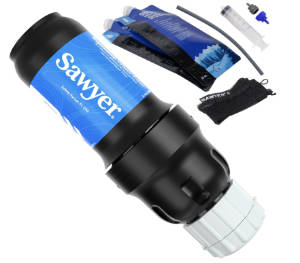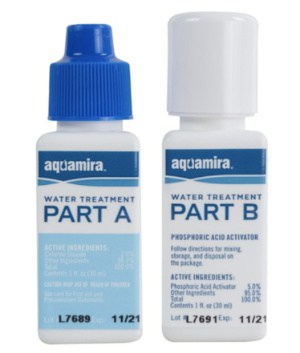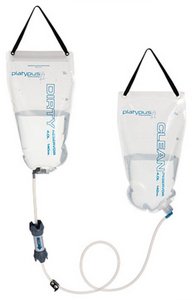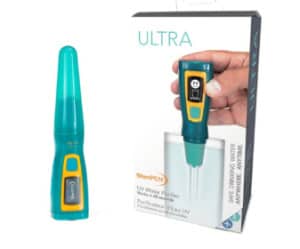What are the best water filter and water purification treatment systems used by backpackers? That really depends on the quality of the water you need to filter or purify, the number of people you need to treat water for, and your personal preferences. For example, squeeze-style water filters, UV purification, and filter bottles tend to be good for solo users and clear water sources, while chemical purification and pump filters/purifiers are good for larger groups and riskier or murkier water sources. Cost and filter longevity are also worth considering.
Here are the 10 best backpacking water filters and water purification systems we recommend for backpacking, hiking, and camping.
1. Sawyer Squeeze Water Filter
The Sawyer Squeeze Water Filter System includes the Sawyer Squeeze Filter, two 32 fl. oz. pouches, a cleaning coupling, and additional accessories for gravity and inline use. Like the Sawyer Mini, you can drink directly from the Sawyer Squeeze but most people squeeze untreated water through it from a soft bottle to a clean container. The filter uses a hollow-fiber membrane filter that removes 99.99999% of all bacteria, such as salmonella, cholera, and E.coli, and removes 99.9999% of all protozoa, such as giardia and cryptosporidium. The filter itself weighs 3 ounces.
Read the SectionHiker review.
2. Platypus QuickDraw
The Platypus QuickDraw is a squeeze-style water filter that screws onto platypus bottles, reservoirs, and 28 mm pet bottles (including SmartWater bottles). It’s sold with a 1L bottle shown here but can also be
purchased by itself. The QuickDraw filter is a hollow fiber filter that physically removes, protozoa, 99.9999% of bacteria, and 99.9% of protozoa, with a flow rate of up to 3L/minute. It can be backflushed or shaken clean. Both ends of the filter can be closed between uses, preventing water from dripping over all of your gear. The weight of the filter and the bottle is 3.6 oz, while the weight of the filter alone is 2.2 oz.
Read the SectionHiker review.
3. Katadyn BeFree Water Filter
The Katadyn BeFree Water Filter can be used as a squeeze filter or hung for group use as a gravity filter if you purchase the 3L version. It has a 0.1-micron microfilter that is EPA tested to remove protozoa (99.99%) and bacteria (99.9999%). It can filter water up to 2 liters per minute, which is very fast for this style of filter. An integrated wide-mouth soft bottle, available in three different sizes, 0.6L, 1 liter, and 3 liters, is easy to fill in streams and folds up compactly when not in use. Weighing 3.5 oz total, the filter alone has a life expectancy of 1000 liters.
Read the SectionHiker review.
4. Aquamira Water Purifications Drops
Aquamira Water Treatment Drops use chlorine dioxide (the same stuff used in municipal water treatment plants) to kill 99.9% of bacteria, viruses, and cysts, including cryptosporidium and giardia. Each package of Aquamira contains two bottles, Part A and Part B, which you mix together before treating your water. The drops are effective in clear, muddy, warm, and cold water and have a shelf life of five years, making them an excellent solution for international travel, hiking, backpacking, and emergency preparedness. Each Aquamira package contains enough drops to treat 30 gallons of water. Many people carry Aquamira as a backup in case their water filter breaks or for purifying several liters of water at once.
Read the SectionHiker review.
5. Platypus Gravity Works
The Platypus Gravity Works water treatment system is a gravity filter that includes two x 4 liter water reservoirs, a water filter, and connecting hoses arranged in a gravity filter configuration. It’s ideal for filtering water for couples or families when you need to filter a large quantity of water quickly. The Gravity Works filter physically removes particles, protozoa, and bacteria down to 0.2 microns in size, including giardia, salmonella, and cryptosporidium. Quick-disconnect valves and a hose clamp make cleaning easy. Filtration speed is over 1 liter per minute and requires no effort once the “dirty” bag is hung. The expected filter lifetime is 1500 liters of water. The entire system weighs 10.75 ounces and stows smaller than most 1L bottles.
Read the SectionHiker review.
6. Katadyn Hiker Water Filter
The Katadyn Hiker Water Filter is a pump-based filter that removes particulates, protozoa, and bacteria down to 0.2 microns in size, including giardia, salmonella, and cryptosporidium. It includes a pre-filter at the hose outlet that filters to 150 microns, good for use with cloudy or sediment-filled water, which removes large contaminants before they reach the main filter and increase its life span. Quick-connect fittings permit removal of input and output hoses: the hoses also connect directly to hydration reservoirs with 0.25 in. drink tubes. The expected filter life is 1150 liters before replacement is required. The Hiker weighs 11 ounces.
7. Steripen Ultra UV Water Purifier
The Steripen Ultra is a water purifier that uses ultraviolet light to neutralize bacteria, protozoa, and viruses that can make you ill. The Ultra is USB rechargeable and fits in narrow or wide-necked bottles. It’s also one of the best solutions for purifying cold water, which will create tiny holes in most filters if it freezes when the filter element is damp in cold weather, thereby destroying them. To use it, you simply dip it in a container of water and stir, until an indicator lamp signals that the water is purified, after about 90 seconds. Weighing just 4.94 ounces, the Steripen Ultra has a UV lamp life of 8000 uses.
Shop at REI
8. Grayl GeoPress Water Purifier Bottle
The Grayl GeoPress is a bottle-based water purifier that removes Protozoa, Bacteria, and Viruses from water sources. The GeoPress has an outer bottle and an inner bottle, with a filter at one end and a drinking spout with a screw-on top at the other. To use it, you pull the inner bottle out of the outer bottle, fill the outer bottle up with suspect water, and then push the inner bottle into the outer bottle like you would a french press. When finished, you can carry your purified water and sip it directly from the bottle for added convenience or decant it to a different container.
Read the SectionHiker review.
9. HydroBlu Versa Flow Water Filter
The HydroBlu Versa Flow Water Filter can be used as an inline, gravity, squeeze, or straw filter without requiring the purchase of additional syringes, connectors, adapters, or replacement gaskets; it’s compatible with all standard 28mm soda bottles and reservoirs including the
CNOC Vecto; it comes with color-coded end caps to keep the intake and output spouts clean; it doesn’t leak between uses, and it has a transparent inspection window so you can determine when it needs to be cleaned. The Versa Flow 99.9999% of waterborne bacteria such as salmonella, cholera, and E.col and 99.9% of protozoa including Giardia and Cryptosporidium.
Read the SectionHiker review.
Shop at Amazon
10. MSR Guardian Purifier
The MSR Guardian is the most sophisticated and effective water purifier available today. Self-cleaning, it has a high flow rate and generates remarkably good-tasting water. While it is an excellent tool for backcountry use and international travel to countries with suspect water, it’s also quite a nice product to have on hand for emergency preparedness at home. The Guardian physically removes viruses, bacteria, protozoa, and particulates, including hepatitis A, E. coli, giardia, and cryptosporidium, and has a pore size of 0.02 microns. Weighing just 17.3 ounces, the Guardian has a self-cleaning filter that constantly purges itself while you filter water so you never have to backflush or scrub the filter element. It also has an exceptionally high flow rate of 2.5L per minute, making it ideal for individual or small-group use.
Read the SectionHiker review.
How to Choose a Backpacking Water Filter or Purifier
Many natural water sources contain microscopic organisms that can cause illness in humans. Most water filters intended for backcountry use will remove bacteria and protozoa, including giardia and cryptosporidium from these water sources. This is usually sufficient in the United States, Canada, and the UK.
- Viruses, often found in international water sources, are hard to remove because they are so small. Finer-grained filters called water purifiers are needed to remove them. They also can be neutralized with chemical purification agents such as chlorine dioxide or ultraviolet light.
- Hazardous minerals and chemicals, including fertilizers and heavy metals, are difficult to remove using most of the solutions listed below which specialize in removing biological contaminants. If you need water in places where such contaminants are present, your best bet is to switch to bottled water or to only drink from safe sources based on local information.
There are a wide number of different water filter and purifier types available. Unfortunately, none of them are foolproof or perfectly suited for all kinds of trips and locales. They also differ in ease of use, the length of time it takes for them to process water, and whether they’re good for solo or group use.
Here’s a summary of the different types of water filters and purifiers and their strengths and weaknesses, with several examples to illustrate the available products in each category.
Squeeze Water Filters
Squeeze filters are single-stage filters that are good for removing bacteria and protozoa, but not viruses. They’re best used with clear water sources that are low in particulates and suspended organic matter to prevent clogging. Processing speed depends on the size of the “dirty” water bottle coupled with the filter and how much pressure the user exerts to push water through it. However, squeeze filters typically slow down with use and must be back-flushed with a cleaning syringe regularly to maintain their flow rate. Some examples:
Gravity and Inline Water Filters
Gravity water filters make it possible to process larger quantities of water at once using the power of gravity. A large water reservoir, called “the dirty bag” is hung from a tree with a hose leading to a water filter. The output of the filter flows out another hose to a clean reservoir, called the “clean bag.” A squeeze-style, single-stage filter is typically used. Gravity filters are good for couples and small groups. An inline water filter uses a similar setup, but the user sucks on the output hose rather than running it to a clean bag. Some examples:
Bottle and Straw Water Filters
Bottle and straw filters usually use the same single-stage, hollow fiber filters used by squeeze, gravity, and inline water filter systems. The user sucks water stored in a bottle or directly from the water source through the filter, rather than transferring it to secondary storage. They are best used by individuals in places where water is abundant. Some examples:
Pump Water Filters and Purifiers
Pump water filters filter out bacteria and protozoa, while pump water purifiers can also remove viruses. They have hand pumps that force water through the filter and out to secondary storage for future use. While pump filters do require some elbow grease to operate, they usually filter water quite quickly and are suitable for use by couples as well as individuals. Most have a pre-filter at the end of the hose that you drop into the water source to remove particulates and organic matter. This can be very handy when you can’t actually reach the water source, like down a steep embankment. They can also be cleaned and replacement filters are usually available. Some examples:
Chemical Water Purification
Chemical water purifiers are available in tablet or liquid form. The best chemical ingredient is chlorine dioxide, which has virtually no taste or color and kills bacteria, protozoa, and viruses. Chemical purification is best used by individuals rather than couples or groups because it takes anywhere from 15 minutes to 4 hours to fully purify water, far longer than other methods. While it is very lightweight, it is relatively expensive when compared to other methods. Many hikers carry chlorine dioxide as a backup to a second primary filter or purification method, as a result. Some examples:
Ultraviolet Light Water Purification
Ultraviolet Light is an effective form of water purification that neutralizes bacteria, protozoa, and viruses. It is best used with clear water since it doesn’t remove any particulates or organic matter. While UV purification is relatively fast, it’s not good for processing large quantities of water. It also depends on working batteries, which can run out of power. Still, it’s one of the few options that works well for cold water when there’s a risk of freezing a filter or purifier and ruining it.
Some examples:
Check Out All of SectionHiker’s Gear Guides!
SectionHiker is reader-supported. We only make money if you purchase a product through our affiliate links. Help us continue to test and write unsponsored and independent gear reviews, beginner FAQs, and free hiking guides.










